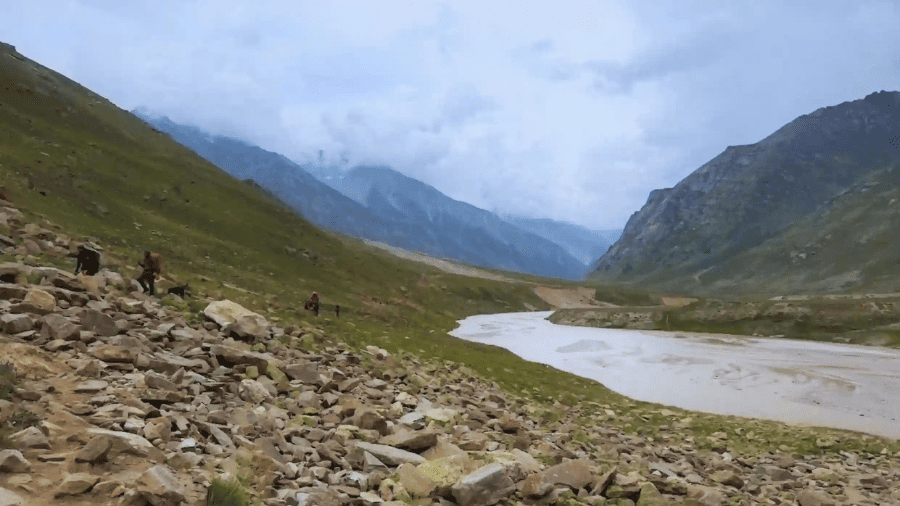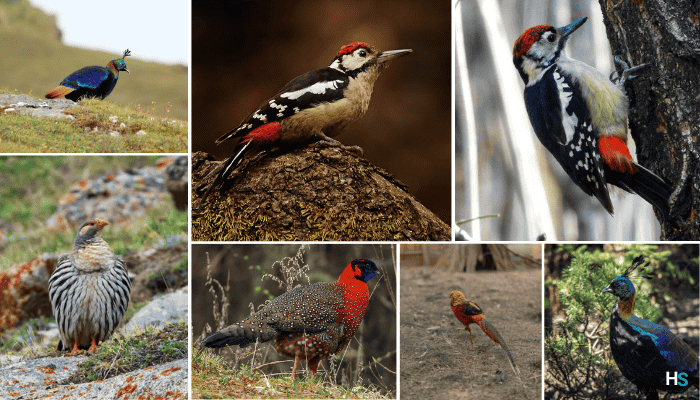
Gangotri Dham : Tour Highlights
The Char Dham Yatra as its commonly called or more accurately the chota char dham yatra is a very important Hindu pilgrimage destination in the Garhwal region of Uttarakhand.
The four destinations in Chota Char Dham are Gangotri, Yamunotri, Kedarnath and Badrinath. It is a spiritual journey which people undertake for cleansing one’s soul, attaining liberation and getting moksha.
The Char dham yatra begins from Yamunotri temple in Uttarkashi district and from their it goes to other three places namely Kedarnath, Gangotri and finally ends at Badrinath which is at the highest altitude. The total distance covered by this yatra is about 2500 kms and can be done on foot which was what people did and still do traditionally or on horsebacks and now helicopter services have also started.
The yatra begins from the auspicious day of Akshay Tritya which falls either in April or May and ends during Diwali. Maximum tourists do the yatra in the first two months itself before the monsoon to avoid being stuck in landslides. In winter months the yatra is closed due to snowfall in the region.
Haridwar, Rishikesh or Dehradun city in Uttarakhand becomes the starting point of Char Dham yatra.
Traditionally, people start the pilgrimage from Yamunotri followed by Gangotri and Kedarnath ending the yatra at Badrinath.
Gangotri
Gangotri is one of the four pilgrim temple of char dham yatra. The temple at Gangotri is dedicated to Goddess Ganga. It is said that Ganga River originates here. Gangotri is a town in Uttarkashi district of Uttarakhand situated at an altitude of 10200 ft or 3100 metres above sea level. The temple opens on Akshay Tritya in April or May till Diwali after which the idol is kept at Mukhba village near Harsil in winters.
Gangotri – How It Originated - Legends & Myths
According to Hindu legends, it is believed that river Ganga descended from heaven at Gangotri when Lord Shiva released the river via his mighty locks. The actual origin of the river is at Gaumukh 19 kms away from Gangotri where it is actually called Bhagarathi river at the origin. This place can only be accessed by trekking. Once the Bhagarathi river meets the Alaknanda River at Devprayag it finally acquires its name Ganga.
It is said that King Bhagiratha prayed to Lord Shiva at Gaumukh to pardon the sins of his ancestors and looking at his dedication Lord Shiva allowed Ganga to flow down.
Another legend here is that Pandavas performed the Deva Yajna here to atone the deaths in the epic battle of Mahabharat. So, Hindus also perform ancestral rites to free the spirits of their ancestors here.
The original Gangotri temple was built by Nepalese general Amar Singh Thapa which was later restored too.
Best Time To Visit Gangotri
The best time to visit Gangotri is from April/ May after Akshay Tritya when the temple first opens to June where the temperatures are very comfortable, they range between 10- 20-degree C. It is also peak season hence we see a lot of tourists during this time owing to summers and vacations in schools and colleges.
The months of September till second day of Diwali are relatively less crowded as the temperatures can drop very low with a high possibility of snowfall in latter months making the journey on foot difficult.
The months of June to September are months of monsoon season which is not a typical time to travel due to frequent occurrence of landslides and road blockages due to heavy rainfall in the region.
From after Diwali till April the temple is shut due to extreme snowfall and sub-zero temperatures.
Places To Visit In And Around Gangotri
- Gangotri National Park – it is located in Uttarkashi district in Uttarakhand and it boosts a forests rich in Deodar, Oak, Pine, Spruce trees. It is here that one will find GAUMUKH from where river Ganga originates. It’s a famous place for treks and hikes around the region and if one is lucky can easily spot Snow Leopards which are native to this place.
- Surya Kund – located 500 meters from Gangotri temple is a beautiful waterfall where the legends believe that Goddess Parvati would bathe here.
- Kedartal – located 17 kms from Gangotri it is one of the most popular treks in Uttarakhand. One can immerse in the natural beauty of the forests while enjoying the backdrop of various Himalayan peaks.
- Pandav Gufa – it is believed that Pandavas rested here on their way to Mt Kailash. It is an approximately 1.5- 2km trek from Gangotri.
Other treks which are quite popular are Gaumukh Tapovan Trek, Dayara Bugyal Trek.
How To Reach Gangotri
As Gangotri is a major pilgrimage destination and part of Char Dham Yatra it is very well connected by major cities like Dehradun which is approximately 230 kms away. From Dehradun the most preferred mode of transport is by road or Helicopter to reach Gangotri.
- By Air: The nearest Airport to Gangotri is Dehradun Airport or Jolly Grant airport which is just 270 kms away and the nearest International Airport is New Delhi International Airport which is more than 500 kms away. Helicopter services are also available from Sahastradhara Road, taking directly to Harsil helipad and from there taxi or car can take you to Gangotri.
- By Rail: Rishikesh and Dehradun railway stations are closest stations to Gangotri and they are well connected with frequent trains from major destinations of India.
- By Road: One can take a road trip from either Dehradun or Rishikesh while taking in the scenic surroundings and visiting popular tourist destination along the way. The road trip will eventually lead to Gangotri temple.
Important Things To Carry
1. Clothing:
- Travelling to Gangotri one will require to be dressed in warm yet comfortable clothing as the weather is quite cold. Layering your clothes hence becomes important and practical.
- Wearing thermal tops and bottoms is a must esp. when travelling during winter months along with some woolen or thermal socks. Over the thermals one can wear layers of other clothing items to keep warm.
- A woolen cap or a beanie will keep one warm especially when winds are strong.
- As one has to undertake a trek to reach the temple comfortable and sturdy shoes are a must.
- A waterproof jacket, torch as it gets dark quite early and sunscreen should be carried too.
- Important thing to note is that shorts, miniskirts, night suits and torn jeans aren’t allowed inside some temple hence it would be better if they are avoided.
- ESSENTIAL DOCUMENTS – As a part of Char Dham Yatra prior registration is COMPULSORY on the official website or app.
2. Essential Documents: A government id proof such as Aadhar card, passport or driving license is required at all hotels or guest houses while you check in. additionally some permits might be required while visiting some national parks and wildlife sanctuaries.
3. Medicines: if you are on any lifelong medicines definitely carry those. Along with it one can carry a few basic medicines for fever and pain relief and some basic first aid stuff like band aids, antiseptics and ointments.
Since it’s a high-altitude region acclimatization is very important and necessary medication and advise has to be followed.
4. Miscellaneous: other items like torch, umbrella, raincoats, sturdy backpack to keep some raincoats etc and sunscreen can be carried too.
Faqs ABOUT GANGOTRI
Q1. Is Helicopter Service Available To Visit Gangotri?
Ans: Not directly to the temple itself but helicopter services are available from Dehradun till Harsil and from there one can take a private car or taxi to reach Gangotri which is 25 kms away.
Q2 What Is The Best Time To Visit Gangotri?
Ans: The best time to visit is as the temple opens on Akshay Tritya in April or May as the temperatures are manageable 12 – 20-degree C till June. During monsoon the risk of landslide is quite high and during winter months the temple is closed due to heavy snowfall in the region.
Q3. Does One Need To Walk A Lot At Gangotri?
Ans: After seeking blessings at Gangotri temple to reach Gaumukh (actual origin of river Ganga) one has to rise early morning do trek and reach Gaumukh and come back down by late evening all in one day itself. One can trek even further to go to Tapovan.
Read more: Yamunotri Dham - Tour Highlights
About Author

Nitisha
Nitisha from Mumbai is a consulting homoeopathic medicine practitioner by profession and a content creator by passion. In her free time she loves to explore new places owing to her love for travelling and thirst for knowledge and history.
Recent news

23 Dec 2025

20 Dec 2025

18 Dec 2025

16 Dec 2025

10 Dec 2025
Recommended Treks

Cost: ₹28000 | $321
Type: Easy - Moderate
Best Time: May to June and September to October

Cost: ₹28000 | $321
Type: Moderate
Best Time: May to June and September to October

Cost: ₹60000 | $688
Type: Easy - Moderate
Best Time: Late April to June